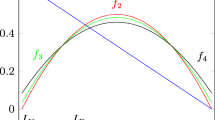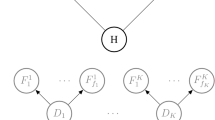Abstract
Diversity of evidence is widely claimed to be crucial for evidence amalgamation to have distinctive epistemic merits. Bayesian epistemologists capture this idea in the variety-of-evidence thesis: ceteris paribus, the strength of confirmation of a hypothesis by an evidential set increases with the diversity of the evidential elements in that set. Yet, formal exploration of this thesis has shown that it fails to be generally true. This article demonstrates that the thesis fails in even more circumstances than recent results would lead us to expect. Most importantly, it can fail whatever the chance that the evidential sources are unreliable. Our results hold for two types of degrees of variety: reliability independence and testable aspect independence. We conclude that the variety-of-evidence thesis can, at best, be interpreted as an exception-prone rule of thumb.




Similar content being viewed by others
Notes
Wheeler and Scheines (2011, 2013), propose different evidential structures, but do not assess the variety-of-evidence thesis with them. Stegenga and Menon (2017) provide a partial assessment limited to noting cases of what they call “dyssynergystic evidence”. We had results for evidential structures in which the hypothesis is caused by other variables rather than being a root node, but we decided not to present them in this article due to space constraints. We can however report that the variety-of-evidence thesis is not better supported in this alternative class of evidential structures.
‘Aspect’ is used for lack of a better word. For comments and the relevant literature on aspects that are not consequences, see Footnote 3.
Although we use \(r_i\) both for the state of variable \(R_i\) (its other state being \(\lnot r_i\)) and for a value of the parameter, namely the prior probability of this state, \(P(r_i)\), this conflation is unlikely to generate confusion.
We also urge the reader to remember that our modeling choices are not covering all possible notions of an unreliable source, see Claveau (2013, p. 98).
This revision to full certainty is a stringent assumption that is dropped in Sect. 4 where we introduce degrees of variety.
For instance, our numerical analysis reveals that any combination of the parameters \(\{\alpha , r\}\) is associated to a reversal of the strength of confirmation between structures A and C (shared reliability) under some values of the other parameters (p, q). This is a pretty strong result: in this comparison, the variety-of-evidence thesis can lead us astray whatever the probability that the source is positively biased (\(\alpha {\bar{r}}\)). In the comparison between structures B and D (independent reliability), 98% of the space \( \alpha \times r\) is susceptible to reversals; only if we have the combination of a highly reliable source (\(r \lesssim 1\)) with a tendency to bias extremely skewed toward a negative result (\(\alpha \gtrsim 0\)) is the variety-of-evidence thesis not subject to counterexamples.
To compare this result with what we found in our comparison of fully shared and fully independent consequences, see Footnote 8. One can also compare this result to the first result in Conjecture 1 (about the degree-of-reliability-independence thesis), which could only generalize over r, not \(\alpha \).
References
Bovens, L., & Hartmann, S. (2002). Bayesian networks and the problem of unreliable instruments. Philosophy of Science, 69(1), 29–72.
Bovens, L., & Hartmann, S. (2003). Bayesian epistemology. Oxford: Oxford University Press.
Claveau, F. (2013). The independence condition in the variety-of-evidence thesis. Philosophy of Science, 80(1), 94–118.
Dowle, M., Short, T., Srinivasan, S. L. W. C. F. A., & Saporta, R. (2013). Data.table: Extension of data.frame for fast indexing, fast ordered joins, fast assignment, fast grouping and list columns. R package version 1.8.10.
Downward, P., & Mearman, A. (2007). Retroduction as mixed-methods triangulation in economic research: Reorienting economics into social science. Cambridge Journal of Economics, 31(1), 77–99.
Earman, J. (1992). Bayes or bust?: A critical examination of Bayesian confirmation theory. Cambridge: MIT Press.
Højsgaard, S. (2012). Graphical independence networks with the gRain package for R. Journal of Statistical Software, 46(1), 1–26.
Howson, C., & Urbach, P. (1993). Scientific reasoning: The Bayesian approach (2nd ed.). Chicago: Open Court.
Istituto Nazionale di Fisica Nucleare. (2011). Particles appear to travel faster than light: OPERA experiment reports anomaly in flight time of neutrinos. ScienceDaily. Retrieved October 26, 2011 from www.sciencedaily.com/releases/2011/09/110923084425.htm.
Kuorikoski, J., & Marchionni, C. (2016). Evidential diversity and the triangulation of phenomena. Philosophy of Science, 83(2), 227–247.
Maxim, L. D., Niebo, R., & Utell, M. J. (2014). Screening tests: A review with examples. Inhalation Toxicology, 26(13), 811–828.
Pearl, J. (1988). Probabilistic reasoning in intelligent systems: Networks of plausible inference. San Francisco: Morgan Kaufmann.
Pearl, J. (2009). Causality: Models, reasoning and inference (2nd ed.). Cambridge: Cambridge University Press.
Schupbach, J. N. (2015). Robustness, diversity of evidence, and probabilistic independence. In U. Mäki, I. Votsis, S. Ruphy, & G. Schurz (Eds.), Recent developments in the philosophy of science: EPSA13 Helsinki, number 1 in European studies in philosophy of science (pp. 305–316). Springer. https://doi.org/10.1007/978-3-319-23015-3_23
Soetaert, K. (2016). plot3D: Plotting multi-dimensional data.
Stegenga, J., & Menon, T. (2017). Robustness and independent evidence. Philosophy of Science, 84(3), 414–435.
Thurmond, V. A. (2001). The point of triangulation. Journal of Nursing Scholarship, 33(3), 253–258.
Wheeler, G., & Scheines, R. (2011). Causation, association and confirmation. In D. Dieks, W. J. Gonzalez, S. Hartmann, T. Uebel, & M. Weber (Eds.), Explanation, prediction, and confirmation (pp. 37–51). Dordrecht: Springer. http://www.springerlink.com/content/t7j6u41256j85028/.
Wheeler, G., & Scheines, R. (2013). Coherence and confirmation through causation. Mind, 122(435), 135–170.
Woodward, J. (2006). Some varieties of robustness. Journal of Economic Methodology, 13(2), 219–240.
Author information
Authors and Affiliations
Corresponding author
Additional information
We thank Cédrik Cormier for research assistance and the participants to the 2016–2017 internal seminars of the Canada Research Chair in Applied Epistemology for thoughtful discussions. François Claveau acknowledges the financial support of Canada Research Chairs [950-230644] and of the Fonds de recherche du Québec—Société et Culture [2017-NP-197564].
Appendix A. Proofs
Appendix A. Proofs
1.1 A.1. Likelihood ratios with Cs as consequences : general and specific evidential structures
\(P(h|e_1,e_2)\) can be represented by the likelihood-ratio form:
Given that the ceteris paribus clause imposes a common \(h_0\) across structures, we can make pairwise comparisons of structures in terms of likelihood ratios directly, noting that:
Likelihood ratio: proof for general structure G
The likelihood ratio for the general structure G can be calculated with the first panel of Table 4 and the two last columns of Table 5:
which is the expression in Table 1. \(\square \)
We can expand this likelihood by substituting the original parameters for the \(\omega \). Using Eqs. (11) and (12), we have:
Likelihood ratios for specific evidential structures can then be calculated by attributing a value of 0 to \(\delta \) and \(\gamma \) for shared reliability and shared consequence, and of 1 for independent reliability and independent consequences:
Likelihood ratio: proof for structure A (shared reliability, shared consequence)
\(\square \)
Likelihood ratio: proof for structure B (independent reliability, shared consequence)
\(\square \)
Likelihood ratio: proof for structure C (shared reliability, independent consequences)
\(\square \)
Likelihood ratio: proof for structure D (independent reliability and consequences)
\(\square \)
1.2 A.2. Comparison of confirmatory strengths with Cs as consequences
Proof of Proposition 1
In terms of likelihood-ratio the proposition is: \(L_{\text {A}} > L_{\text {D}} \), for all admissible values of \(p,q,r,\alpha \).
which is true by assumption 7. \(\square \)
Proof of Proposition 2
\(L_{\text {A}} > L_{\text {B}} \) and \(L_{\text {C}} > L_{\text {D}} \), for all admissible values of \(p,q,r,\alpha \).
We start by the first inequality:
The division by \(p-q\) to get to the last line leaves the direction of inequality unchanged because of assumption 7 \(p > q\). Since r and \(\alpha \) are assumed to be always strictly positive, the inequality holds.
Now the second inequality:
Since p \(< 1\) and q \(< 1, 2 - \mathrm{(p + q)} > 0\) is always true. Thus, we need to prove that p + q − 2pq \(> 0\) is always true :
Since 0 \(\le \) q \(\le \) 1 and 0 \(\le \) p \(\le \) 1, then \(\frac{1}{q}\)\(\ge \) 1 and \(\frac{1}{p}\)\(\ge \) 1, which entail that the sum of both fractions is superior to 2.
\(\square \)
Proof of Proposition 3
Starting with the first inequality:
Expression 14 being as claimed in the proposition.
To ease the proof for the second inequality, define the following expressions:
Starting from the inequality implied by the variety-of-evidence thesis, we have:
\(\square \)
Proof of Proposition 4
To prove that the inequality holds if the first disjunct holds, we start with the likelihood ratio for the general structure and impose \(p=1\) and \(q=0\):
This likelihood ratio is identical to the expression in Claveau (2013, eq. 11) which implies that the results in expression (13) and in Fig. 4 of this article also hold here.
Proving the second part of the proposition requires more work. Starting from the likelihood ratio of the general structure and imposing \(\gamma =0\):
Taking the derivative of this expression with respect to \(\delta \):
Using the inequality claimed by the degree-of-reliability-independence thesis:
The derivatives of the \(\omega \) with respect to \(\delta \) are:
Substituting these derivatives in the inequality, we have:
The last line being exactly the inequality claimed in Proposition 4.
\(\square \)
Rights and permissions
About this article
Cite this article
Claveau, F., Grenier, O. The variety-of-evidence thesis: a Bayesian exploration of its surprising failures. Synthese 196, 3001–3028 (2019). https://doi.org/10.1007/s11229-017-1607-5
Received:
Accepted:
Published:
Issue Date:
DOI: https://doi.org/10.1007/s11229-017-1607-5




